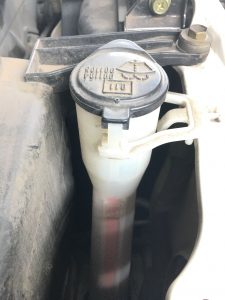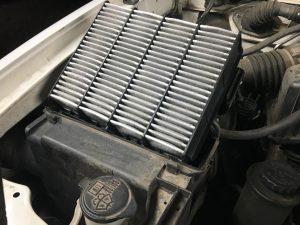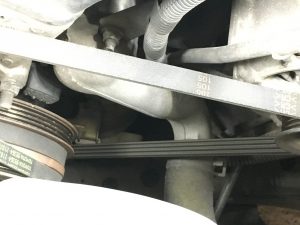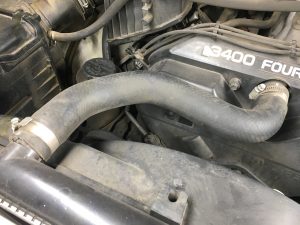In another post we talked about some exterior maintenance items you can do at home. In this one we’re going to open up that hood and do some simple under hood maintenance. Again I’m going to focus on things you can do with little money and basic skills. So, let’s pop that hood and get to it.
Topping Off Windshield Washer Fluid
Cost: $2-$6 for a gallon of washer fluid

Windshield washer filler cap and neck.
Since we already checked and possibly replaced the windshield wipers let’s check the fluid. Most cars have a windshield washer fluid bottle under the hood. A lot of the newer cars, after around 2003, have the washer bottle near the front of the vehicle. In fact, you will probably only see the lid and a long filler neck.
Some of them will have an indicator of how full they are, but some don’t. Top that fluid off with some good quality washer fluid. Doing this under hood maintenance will help keep you safe when your windshield is dirty.
 WARNING
WARNING: Do not fill this with plain water. If you do and the water freezes you will end up with a cracked washer fluid bottle. Bottles with cracks in them may not hold fluid anymore. Save yourself the headache of having to replace the bottle and just pay a few $$ and buy washer fluid.
Checking/Changing the Air Filter
Cost: $6-$25

Air filter and air filter box
Your engine relies on clean air to run smooth. A clean air filter lets more air through and then your engine won’t work so hard. Dirty air causes more wear and tear on the internals of the engine.
Find that airbox and open it up. Check the air filter to see if it is dirty. Most standard air filters are bright white when new. If it’s full of dust, dirt, bugs or other debris then it’s time to change it. If it’s dark gray then it’s time to change it.
Changing your air filter can extend the life of your vehicle. This under hood maintenance can also increase your fuel economy.
Checking Belts
Cost: Free to check them, Belts can cost from ~$8-$45 each
The accessories on your engine are driven by a belt, or several belts. The alternator generates the electricity that your vehicle needs

Multi v-groove drive belt for alternator
and charges the battery as well. The power steering pump creates hydraulic pressure to reduce steering effort. The air conditioning compressor pressurizes refrigerant to cool the cabin of your vehicle. Depending on the vehicle the radiator fan could be run by a belt as well.
On some vehicles there is a separate belt for each of the accessories. On other vehicles there is a single belt. If your vehicle utilizes a single belt it is called a serpentine belt since it snakes its way around all of the pulleys.
You will want to look at the belts for cracks or splits. Cracks will go across the belt perpendicular to the length. Splits can happen and are parallel to the length of the belt. Also look for fraying or other signs of wear. If the inside of a belt looks polished it is called glazed. When a belt is cracked, split, or glazed it should be replaced.
Performing this under hood maintenance check will help keep you from breaking down.
Checking Hoses
Cost: Free to check them, hoses can cast from $5-$25 each
The hoses in your engine bay carry a myriad of different substances. Radiator or heater hoses carry coolant. Air hoses carry air. Vacuum hoses carry a vacuum.

Upper radiator hose
If radiator or heater hoses bulge or crack they can burst and cause your engine to overheat. When air hoses crack they can introduce contaminants into the engine. Vacuum leaks will cause the engine to run rough and can also introduce contaminants.
This under hood maintenance check is really just honing your sense of observation. Look at each of the hoses under the hood. See if you can find cracks or bulges. If you do find cracks or bulges have those hoses replaced.
If the cracks are in air hoses or vacuum hoses then you can easily replace them yourself. Radiator or heater hoses pose another level of complexity due to the contents of the hose.
 WARNING: Do not fill this with plain water. If you do and the water freezes you will end up with a cracked washer fluid bottle. Bottles with cracks in them may not hold fluid anymore. Save yourself the headache of having to replace the bottle and just pay a few $$ and buy washer fluid.
WARNING: Do not fill this with plain water. If you do and the water freezes you will end up with a cracked washer fluid bottle. Bottles with cracks in them may not hold fluid anymore. Save yourself the headache of having to replace the bottle and just pay a few $$ and buy washer fluid.



